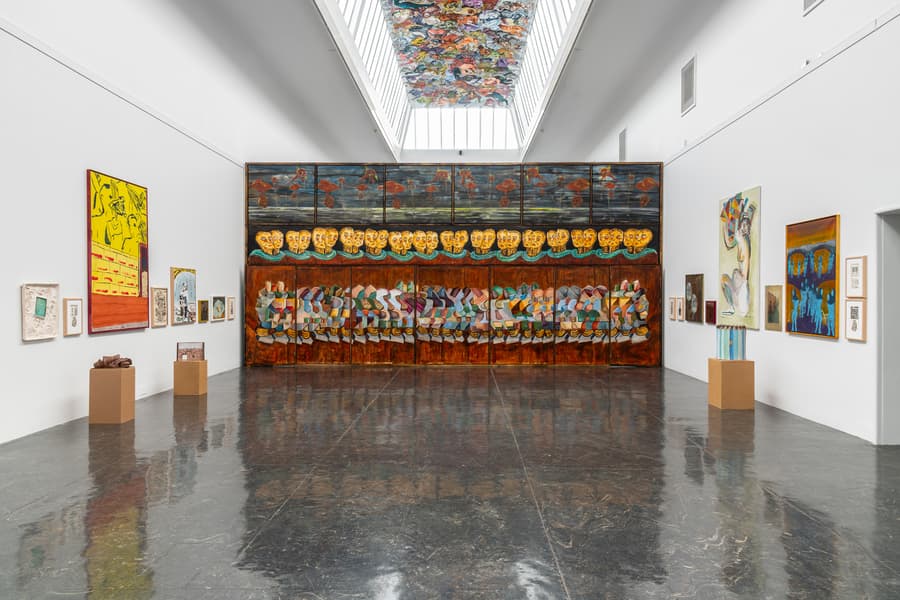Johan Fredrik Michelet

Retrospective exhibit
I first met Fred Michelet at a student evening at the Academy of Fine Arts in 1938. He started a discussion about modern art, and he rattled off names like Cézanne, Picasso and Bonnard in a way that showed he was familiar with the material. But he also made the gullible assumption that the academy students were equally informed, so he was left quite alone and without an answer when his post was finished. I tried a little, and after that a lifelong friendship was formed.
At the time, Michelet was an engineer, employed by a company as a draftsman. He had arranged for him to take work home with him so he could be at the academy in the mornings. The goal was to enter Professor Georg Jacobsen's special class. There they learned that a picture follows laws that have to do with optics and harmony, and that was exactly what he needed as an artist student.
Since then, Michelet has never let go of his view of the picture as a micro-cosmos: The elements in the painting must be arranged in such a way that they somehow represent the connection that is the condition for Our eye to discover reality.
With this, only one side of his art is affected. I experienced the second in a wonderful way — an October morning in Østfold's forests. The war had come. The situation became too difficult for both of us in Oslo. We settled in Rygge and were forest workers for a while. We had walked quite far in the field and reached a little before the sun was due to rise towards a small river where there was a farmer's saw made of boards that were gray with wasps. As the first glimmer of the eastern sky brushed the table wall, it became like silver. I heard a sniff from Michelet and asked if he had caught a cold. But the fact was that this giant of a man stood and cried and said that this is too much for a human being. We then took out our sketchbooks and set about painting the vision, and thus the poetry of it went into battle with the recalcitrance of the palette and the canvas.
In those years, Michelet constantly tried to reach the secret of painting by means of a depiction of nature in which the elements were faintly geometrically arranged. Immediately after the war, he came to France with a scholarship and there encountered a far stronger abstracting tendency among the painters we could call the "Post-Cubists".
The artistic vision Michelet came home with was new and unfamiliar here. The color was constantly applied as clean surfaces. The contours cut into the surfaces and indicated the shapes in the simplest possible way, while at the same time participating in the geometric background play. The new style allowed Michelet to mix nature and imagination. At the autumn exhibition, he presented a picture called "Kastanja", in which a female figure and flowering chestnut branches form part of an equally poetically complicated interplay like the images in a Wergeland stanza.
Now Fred Michelet also wrote the book translated as "Modern painting" and, as the first in Norway, presented the principles behind the endeavors of the non-figurative French painters. His own painting soon abandons the constant division into color areas and contours. Now he resolves each individual color in many steps, tries to play with the entire color circle in each image, and gets a bad rap from the criticism for his powerful use of red and green. For a time, his pictures rationalize themselves so that they only consist of vertical and horizontal strokes of colour that are graded from the highest purity to complicated shadow depths.
The painting Michelet presents today seems to me like a closed synthesis of everything he has struggled through. The disposition of the masses on the surface is still determined by the view of nature on the one hand and the image geometry on the other. The colour appears in an infinity of steps applied with a coarse brush, one tone on top of the other. But each image now has its own character. It starts from a colour theme that is played out the way a composer plays out a musical theme. There are winter pictures in blue-gray against a distant golden light and there are autumn pictures in brown, orange and violet, glowing like old tapestries, and all the green of summer is allowed to swell and spread over paths of last year's brown-red bare fall.
Culture, says Hans E. Kinck somewhere, is conscious nature. The word could fit as a motto for Michelet's art.
- Håkon Stenstadvold


